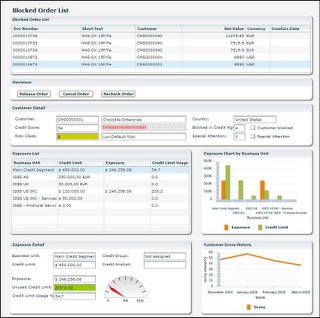At Siebel Systems, where I worked from 2000-2005, after we purchased nQuire in 2001 (which has since become Oracle Business Intelligence Enterprise Edition), we progressed through through four phases of linking the strategic (analytic applications) and execution (sales force automation, call center) systems.
- In the first phase, we enabled users to go to Siebel Analytics directly from tabs in Siebel Call Center, a very minimal IFRAME based integration.
- In the second, we created a concept of an “action link”, which allowed the user from a Siebel Analytics screen to navigate directly from a result record (e.g. the top opportunity in a top 10 list) to the actual opportunity in the Siebel Sales Force Automation application, where the user could then take immediate action. This was a very powerful concept that remains key to the Oracle Fusion Applications value proposition.
- In the third phase, based on technology that I along with my colleague developed, we provided customers the ability to embed contextual analytics from Siebel Analytics directly into the SFA or Call Center application. For example, the top part of the screen would have a list of the 10 opportunities assigned to a sales rep, and in the bottom part, a set of contextual analytics about that opportunity. As each new opportunity was highlighted, the analytics would update without the user ever leaving their context. This opened up a whole new range of possibilities.
- In the fourth phase, leveraging technology from Sigma Dynamics and now called Oracle Real-Time Decisions, using a combination of predictive analytics and business rules (see James Taylor’s excellent blog for a wealth of information on the topic), we were able to prescribe at the moment of contact with the customer a recommendation for how to treat them (e.g. upsell, free offer, etc.) based on a combination of their current context (for example what they pressed in the IVR tree) along with their historical data from the data warehouse. Here then was the combination of real-time, predictive analytics enacted at the moment of insight that we had all been waiting for in the industry, delivered in a packaged fashion.
From a technology perspective, what was great about the Siebel Analytics offering was the common information model and how rich it was combined with a very rich web layer. Through a combination of internal development as well as the purchase of Informatica’s analytical applications IP, we were able to develop a comprehensive package of analytic applications that spanned many roles, processes, and metrics from sales to service to supply chain to financials to human resources, which Oracle still sells quite sucessfully today. However, it wasn’t until I went to Hyperion Solutions that I understood just how rich the analytical world could be. The reporting, dashboards, and packaged analysis capabilities of Siebel Analytics were just a small part of a much larger world that contained scorecarding, initiative management, business modeling, activity-based costing, planning, budgeting, and forecasting, and financial consolidation and reporting. But Hyperion played almost exclusively in finance, and my immediate thought at the time was, “how do we layer the Hyperion scorecarding, planning, and modeling solutions across the entire enterprise value chain just like we had done with Siebel Analytics?” If a company could do that, and link to the transactional systems, I believed it would be industry changing.
Sure enough, right around that time, SAP announced their xApp Analytic Applications, and I was stunned. This was a family of analytic applications, built using a visionary model-driven tool called Visual Composer, that was designed from the outset to integrate analytics and transactions using web services. Even more interesting was that the applications had an incredible Flex-based user experience that was easily competitive with all the leading BI vendors.
I was convinced at that time, that if any vendor could deliver on the vision of Strategy-Driven Execution, it had to be SAP. They owned the largest transactional applications installed based in the world, understood processes across many horizontal and vertical slices, were service-enabling all of those processes, and now had an exciting analytic capability. I jumped at the chance to be a part of this in 2005.
In short order, things changed very dramatically in the technology landscape. Oracle acquired PeopleSoft, Siebel, and then Hyperion, thereby also amassing an incredible set of strategic and execution assets, and SAP acquired Virsa, Pilot Software, OutlookSoft, and Business Objects. The pieces were now all in place for SAP and/or Oracle to realize the vision of Strategy-Driven Execution in their comprehensive product portfolios.
In short order, things changed very dramatically in the technology landscape. Oracle acquired PeopleSoft, Siebel, and then Hyperion, thereby also amassing an incredible set of strategic and execution assets, and SAP acquired Virsa, Pilot Software, OutlookSoft, and Business Objects. The pieces were now all in place for SAP and/or Oracle to realize the vision of Strategy-Driven Execution in their comprehensive product portfolios.






No comments:
Post a Comment